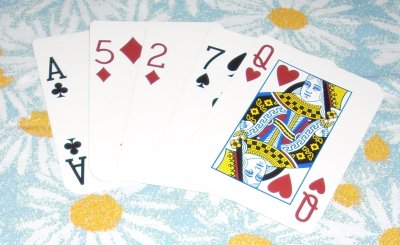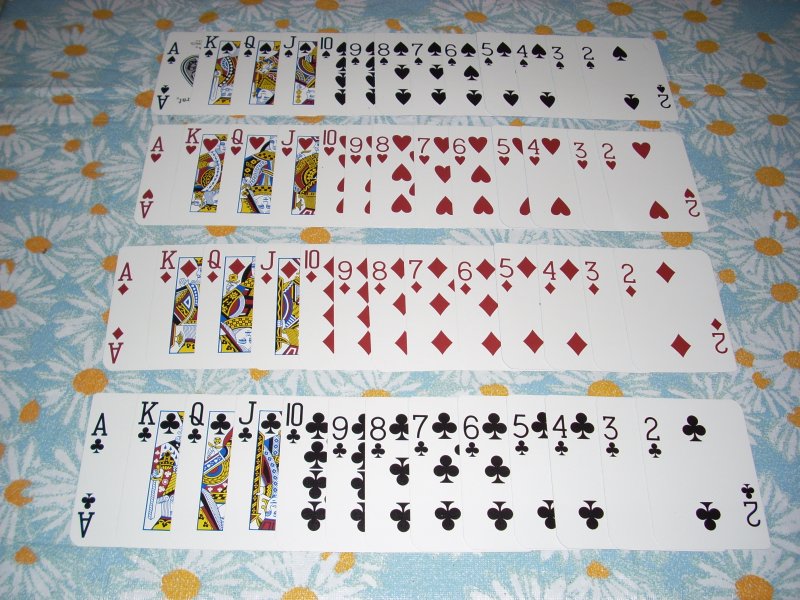|
My sometime correspondent Nathan Lithobolia, posed this question in response to what he considered my hasty dismissal of random chance initiating life on Earth.
"Suppose you walked into a room and found a royal flush in spades face up on the table with the remaining cards of the deck stacked neatly face down. Clearly the probability of dealing that particular hand is low. Would you conclude that you were witness to a miracle - or that the only way to account for that hand showing up was intelligent design?"
Lets examine the question. First of all a royal flush is no less likely to be dealt than any other specific hand of five cards. If we define a miracle as a very improbable event, to answer Nathan's first question we will have to examine the probability of dealing a specific 5-card hand from a well shuffled deck of 52 cards. Suppose you did walk into a room and see a deck of cards on a table with 5 of them turned face up, from left to right: an ace of clubs, a five of diamonds, a two of diamonds, a seven of spades and a queen of hearts. What was the probability that the hand was dealt in a single try?
Well... It depends. The probability of getting some unspecified hand of five cards from a deck of 52 in a single try is 100% or 1/1. If the hand was dealt without preconditions, it is just a child of chance, easily produced in a single try (But try doing it twice in a row.) If, before the deal, we set the precondition that the hand must meet certain specifications, for example we wanted an ace of clubs, a five of diamonds, a two of diamonds, a seven of spades and a queen of hearts, in any order, the probability of meeting our specifications in a single try goes way down.

Assuming a well shuffled deck to start with, the chance that the first dealt card would be in that hand would be 5/52, the number of cards in the hand divided by the number of choices from the deck. The chance that the second card dealt would be one of the remaining 4 cards in the hand would be 4/51. For the third card the chance would be 3/50, the fourth card 2/49 and the fifth card 1/48.
The probability that any pre-designated hand would be dealt in a single try would be the product of the individual probabilities:
5/52 X 4/51 X 3/50 X 2/49X1/48 = 120/311,875,200 = 3.85e-7.
This is 1 chance in 2,598,960.
If we specified that the hand to be dealt must come out in the left-to-right order specified above then we get a smaller probability:
1/52 X 1/51 X 1/50 X 1/49 X 1/48 = 1/311,875,200 = 3.21e-9.
This is 1 chance in 311,875,200.
Now if we are informed that the hand was laid out in a single try the most reasonable assumption is there is nothing special about that hand, being just a child of chance as described above. If we are told in addition that the person laying out the cards declared ahead of time what the hand would be, there is still a non-zero probability that the hand was simply a child of chance and it remains to be argued whether that probability is low enough for its appearance to constitute a miracle.
Regarding the intelligent design question, if the hand was assembled in an unorthodox way such as selecting the cards from the deck spread face up the probability of getting a special hand, even in a certain order is, 100% again, 1 chance in 1 try. Even I, if allowed to intelligently design a hand under these conditions could produce any hand you name in any order you like. This is an example of the power of intelligent design in bringing about improbable results.

How does this relate to the random chance of initiating life on Earth? How does the probability of producing a prescribed 5-card hand from a deck of 52 cards by chance compare with the probability of assembling in specific order a 3D jigsaw puzzle of some 4e11 pieces of which there are only 92 kinds, drawn from a deck of an unknown number of available atoms? Clearly I have not done the math, but my gut tells me that the chance of producing the prescribed hand of cards is a relative dead certainty when compared to the chance of producing the prokaryote cell which is the 3D jigsaw puzzle described above.
|




